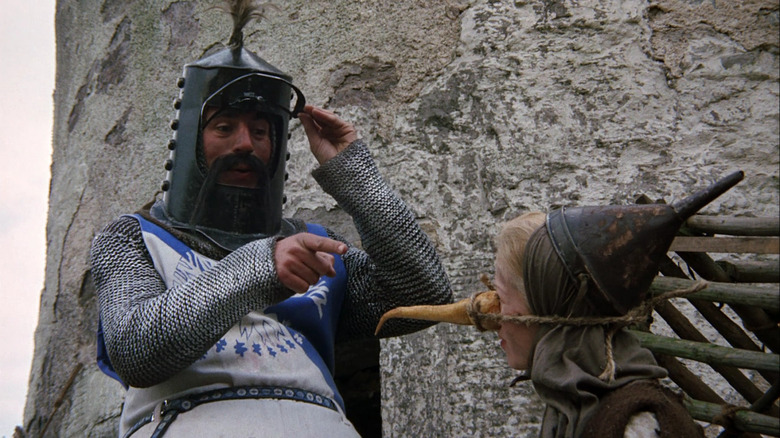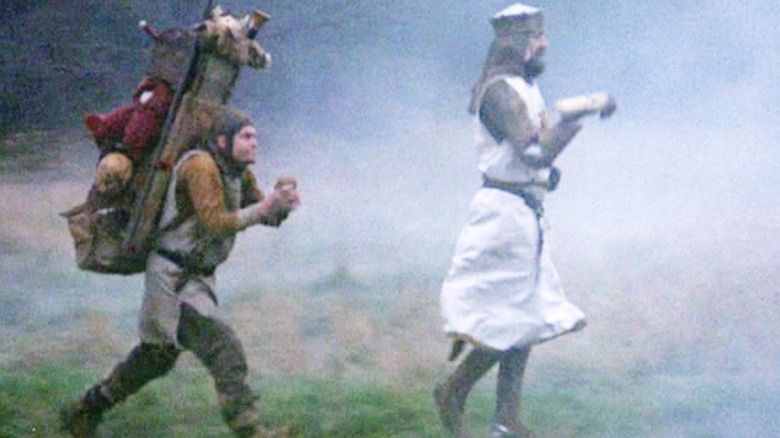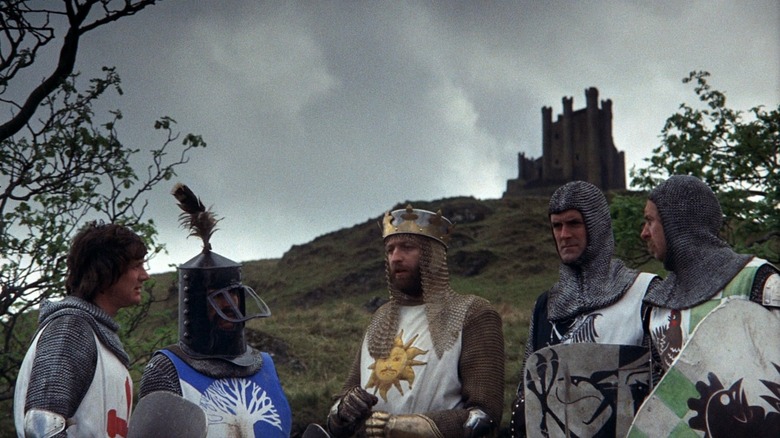The Joke That Inspired Monty Python And The Holy Grail
An important question to ponder: What if I was expecting the Spanish Inquisition?
In Terry Jones and Terry Gilliam's film "Monty Python and the Holy Grail," subtitled "Mønti Pythøn Ik Den Hølie Gräilen" (A.D. 1975), an English king named Arthur (Graham Chapman) assembles a retinue of knights, three or five of them in toto, in order to complete a task assigned to him by God (also Chapman, speaking out of a photograph famed cricketer W.G. Grace, 1848 -1915). He must find the missing Holy Grail, which appears to be a glass of some kind. The film was filmed in a particularly muddy part of Scotland on a budget that would make a modern Marvel movie laugh to the point of unintended urination. It was released to an unwitting public that embraced it as one of the greatest films of 1975, a distinction it would share with Andrew V. McLagland's cop thriller "Mitchell."
"Monty Python and the Holy Grail" was the second film put out by the famed English comedy troupe, the first being 1971's "And Now for Something Completely Different," an anthology film. That film was constructed out of bigger-budget remakes of some of Python's more notable sketches from the first two seasons of "Monty Python's Flying Circus," and few of the troupe's fans count it as one of their "real" movies.
John Cleese, who played Sir Lancelot and Tim the Enchanter in "Holy Grail" agrees with this assessment. He also revealed that "Holy Grail," while certainly sketch-like in its structure, was initially meant to be another anthology-type picture. It wasn't until co-star Michael Palin mentioned coconuts that the film blossomed into the epic it became. In a 2017 interview with the Morning Call, Cleese elucidates.
Coconuts?
The Michael Palin sketch in question was born from the fact that "Monty Python and the Holy Grail" would likely be unable to afford real horses. Palin's solution was simple: Actors would mime riding horses — knights would galumph on their own feet — with their manservants clacking empty coconut halves together behind them, approximating the sound of hoofbeats. That grew into a sketch about a pair of men atop a castle wall questioning King Arthur about how coconuts — a tropical fruit — ended up in the misty climes of England. This conversation, in turn, spins off into multiple theories as to how swallows might be able to carry them during their migration cycles.
Cleese recalls how it was that one joke in particular — the coconut gag — pushed the entire film into its intended timeframe. Really, it was the Pythons' inability to provide horses for themselves that, perhaps poetically, drove them to make a film set in a time when horses were the primary form of transportation.
"And we started writing it and we had no idea what we were doing, and 90 percent of the first draft, we threw out. Ninety percent. And then Michel wrote the sketch about the fellow on the castle walls asking about coconuts, and we suddenly thought, 'Right, it's all going to be set in medieval times. And once we knew that, we were able to go off and think about Medieval times and start writing sketches, really, that were to do with the time — like 'Bring out your dead' — that weren't really part of any real plot."
But a plot would kind of grow. Kind of.
It is a silly place
Once the medieval setting was decided, many sketches and scenarios began to blossom. Watching "Flying Circus," one might find that a great deal of the show is constructed of parodies of British television in the late 1960s and early 1970s. There are many parodies of BBC documentaries, movies, and quiz shows. Even if one wasn't watching BBC programs at the time, it's clear that a great number of educational history shows were being broadcast, and "Holy Grail" falls in line with that sensibility. Indeed, a modern-day historian (credited by the chyron "A Famous Historian") even makes an appearance. In the film's most fitting symbol, a masked knight gallops into frame (on one of the film's only real horses) and assassinates him. Without revealing anything, that historian plays into the film's ending.
Cleese talked about how what began with a spoofery of documentaries grew into a legitimate film story, and how the ending, he felt, could have been funnier. He said:
"[E]ver so slowly, we got the notion that if we made it about individual knights, and how they sort of got together and were given a ... what? A quest, to look for the Holy Grail ... we sort of saw that there was a shape to it. But if you look at the movie now, it's got some wonderfully funny scenes to it, particularly in the first half. But it's not terribly good as a story. I'm not a big fan of a lot of the ending. I think the ending sort of ... very visual, but less funny."
Those who have seen "Holy Grail" can attest to the brilliance of the ending. Cleese can rest assured he did a good job.


